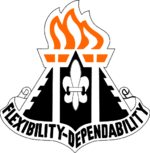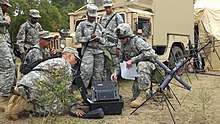11th Signal Brigade (United States)
The 11th Signal Brigade ("Desert Thunderbirds") of the United States Army is an element of Army Forces Command.[2] It is based at Fort Hood, Texas. The unit mascot is the Thunderbird, a hawk-like bird perched upon a globe shooting thunderbolts out of its eyes. Soldiers in this unit call themselves "The Thunderbirds."
| 11th Signal Brigade | |
|---|---|
.svg.png) 11th Signal Brigade Shoulder Sleeve Insignia | |
| Active | 1964–present |
| Country | |
| Branch | |
| Type | Communications |
| Role | EAC Communications |
| Part of | Army Signal Command |
| Garrison/HQ | Fort Hood |
| Nickname(s) | "Thunderbirds" (Special Designation)[1] |
| Motto(s) | "Flexibility, Dependability" |
| Engagements | Operation Desert Storm Operation Restore Hope Operation Enduring Freedom Operation Iraqi Freedom |
| Insignia | |
| Distinctive Unit Insignia |  |
History
Designated Headquarters and Headquarters Detachment, 11th Signal Group, 4 September 1964, to support the Joint Chiefs of Staff worldwide contingencies. The 11th Signal Group was originally assigned to Fort Lewis, Washington, as part of STRATCOM, the U.S. Army Strategic Communications Command. The group became a regular participant in exercises in Alaska.
On 25 April 1966 the group was reorganized and redesignated Headquarters and Headquarters Company, 11th Signal Group. The following December, the group was reassigned to Fort Huachuca, Arizona.
As the 11th Signal Group the unit contained: HQ, HHQ, and five companies, 505th, 521st, 526th, 557th, and Mobile Operations Signal Companies.
Units of the group participated in Operation Power Pack in 1965.
The group was designated 1 October 1979 as Headquarters and Headquarters Company, 11th Signal Brigade.
During the 1980's, the 11th Signal Brigade forward-deployed two provisional companies: Company B (Separate) at Soto Cano Air Base in Honduras to support Joint Task Force Bravo, and Company C (Separate)in Bahrain to support United States Central Command.
After Iraq's invasion of Kuwait in August 1990, the 11th Signal Brigade (minus two companies that remained to execute other contingency missions) deployed to Saudi Arabia in support of Operations Desert Shield and Desert Storm.
The 11th Signal Brigade deployed some of its Signal personnel to East Timor in 1999 supporting the U.S. contingent with INTERFET.
On 7 June 2013, the unit cased their colors for the last time on Fort Huachuca and unfurled them on 26 June 2013, at Fort Hood, Texas.[3]
Operation Enduring Freedom
The 11th Signal Brigade deployed shortly after the 11 September 2001 attacks to support ARCENT in its position as CFLCC. During OEF in 2002, the 11th Signal Brigade had soldiers and civilian personnel supporting CFLCC Forward in Uzbekistan, the U.S. Army's 10th Mountain Division in Bagram, Afghanistan and Task Force Rakkasan (3rd Brigade Combat Team, 101st Airborne Division), in Kandahar, Afghanistan. They also had soldiers deployed to Djibouti, Africa in support of Combined Joint Task Force, Horn of Africa (CJTF-HOA). The "Thunderbird Brigade," successfully performed its mission of providing Command, Control, Communications, Computers, and Internet (C4I) services to the warfighter but soon deployed back home to Fort Huachuca, Arizona shortly after establishing tactical communications networks for coalition forces.
Operation Iraqi Freedom
Shortly after its deployment supporting OEF, the 11th Signal Brigade reconstituted and deployed to the now closed Camp Doha, Kuwait to support CFLCC in early 2003. It successfully enabled the warfighting commanders which included GEN Tommy Franks of USCENTCOM, LTG David McKiernan of CFLCC and LTG William Wallace of V Corps (later commanded by LTG Ricardo Sanchez) to have real-time battlefield communications capability in the Iraqi theater of operations. The 11th Signal Brigade was featured in the History Channel's show Tactical to Practical for its efforts in implementing the use of COTS or "Commercial-off-the-shelf" information technology equipment in a real-world military operation.
Subordinate units

The 11th Signal Brigade is an Echelons Above Corps or "EAC" Signal Brigade. It comprises the following units:
- Headquarters and Headquarters Company (HHC), 11th Signal Brigade
- 40th Expeditionary Signal Battalion (40th ESB), Location: Fort Huachuca, AZ
- 57th Expeditionary Signal Battalion (57th ESB), Location: Fort Hood, TX
- 62nd Expeditionary Signal Battalion (62nd ESB), Location: Fort Hood, TX
- 86th Expeditionary Signal Battalion (86th ESB), Location: Fort Bliss, TX
The 51st Signal Battalion is no longer part of the 11th Signal Brigade. It is a subordinate unit of the 35th Signal Brigade.
Capabilities
The 11th Signal Brigade provides echelon-above-corps signal support (EAC). It has the capability to install, operate, and maintain a tactical communications network supporting either joint or Army organizations, establish command center communications nodes, area signal centers, and small extension nodes. It provides installation, construction, and test teams on a worldwide basis during peacetime, war, and operations other than war, and in response to emergency requirements to restore or expand information systems facilities. Also, the brigade provides on-site training in the operation and maintenance of new or modified non-tactical information systems and limited commercial-off-the-shelf communications equipment and systems at worldwide locations.
Due to its total communications capabilities, the brigade can support the full spectrum of operations ranging from combat to peacekeeping to humanitarian. Since 1990, the brigade has participated in numerous contingency operations. The entire brigade took part in Operation Desert Shield/Storm. At the height of that operation, the brigade controlled more than five signal battalions and operated the largest tactical communications network since World War II. For its service during these operations, the brigade was awarded the Department of the Army Meritorious Unit Commendation. The brigade also took part in Operations Restore Hope and Continue Hope in Somalia from December 1992 to March 1994; Operation Intrinsic Action/Southern Watch in Kuwait from August to October 1992; and Operation Uphold Democracy in Haiti from September 1994 to March 1996. Brigade soldiers have also supported operations in Korea, Guantanamo Naval Base, Cuba, and Saudi Arabia. Most recently, the brigade supported Operation Desert Thunder in 1998 with a brigade task force.
The principal communications capabilities of the unit include tactical satellite, tropospheric scatter, super high frequency, and ultra high frequency line-of-sight transmission systems, and voice, message, and data switches. The brigade's communications networks are compatible with the mobile subscriber equipment communications networks found at corps and division level. Commanders use C2 to control, direct, and coordinate military forces to accomplish their missions. This process encompasses the personnel, equipment, communications, facilities, and procedures necessary to gather and analyze information; to plan for what is to be done; to issue instructions; and to supervise the execution of operations. Communications allows commanders to direct operations on the battlefield and to monitor their execution. It is a critical element to battlefield synchronization.
Past commanders
NOTE: This is an incomplete list. Please update with previous commanders
| Title | Name | Start | Finish | Relevant Operations |
|---|---|---|---|---|
| Group Commander | COL Thomas B. Richey | 1966 | 1968 | |
| Brigade Commander | COL Edwin W. Chandler | 1978 | 1980 | |
| Brigade Commander | COL Roy L. Loudermilk, Jr. | Oct 1980 | Oct 1980 | |
| Brigade Commander | BG Mark Weiberger | 1980 | 1988 | |
| Brigade Commander | COL John M. Watkins Jr. | 1986 | 1988 | |
| Brigade Commander | COL Charles G. Sutten, Jr. | Nov 1988 | Dec 1990 | Operation Desert Shield |
| Brigade Commander | COL Andrew C. Follmer II | Dec 1990 | Dec 1992 | Operation Desert Shield/Desert Storm |
| Brigade Commander | COL James E. Downey | Dec 1992 | Sep 1994 | |
| Brigade Commander | COL James C. Hylton | Sep 1994 | Sep 1996 | |
| Brigade Commander | COL Kenneth C. Gongaware | Sep 1996 | July 1998 | Operation Desert Thunder |
| Brigade Commander | COL Daniel R. Judy | July 1998 | Aug 2000 | East Timor |
| Brigade Commander | COL Mark S. Bowman | Aug 2000 | Aug 2002 | Operation Enduring Freedom |
| Brigade Commander | COL Brian R. Hurley | Aug 2002 | Aug 2004 | Operation Iraqi Freedom |
| Brigade Commander | COL Michael S. Yarmie | Aug 2004 | Aug 2006 | Operation Iraqi Freedom |
| Brigade Commander | COL John B. Hildebrand | Aug 2006 | Feb 2009 | Operation Iraqi Freedom |
| Brigade Commander | COL Francis J. Huber | Feb 2009 | Mar 2011 | Operation Iraqi Freedom |
| Brigade Commander | COL Patrick Dedham | Mar 2011 | June 2013 | Operation Enduring Freedom |
| Brigade Commander | COL James Parks III | June 2013 | July 2015 | Operation Enduring Freedom |
| Brigade Commander | COL Gary G. Ridenhour | July 2015 | July 2017 | Operation Enduring Freedom |
| Brigade Commander | COL David Thomas | July 2017 | July 2019 | Operation Inherent Resolve |
| Brigade Commander | COL Brian C. North | July 2019 | Present | Operation Inherent Resolve |
References
- "Special Unit Designations". United States Army Center of Military History. 21 April 2010. Archived from the original on 9 June 2010. Retrieved 24 June 2010.
- "NETCOM Journal, Nov 2009" (PDF). Archived from the original (PDF) on 7 August 2011. Retrieved 22 December 2018.
- Army.mil